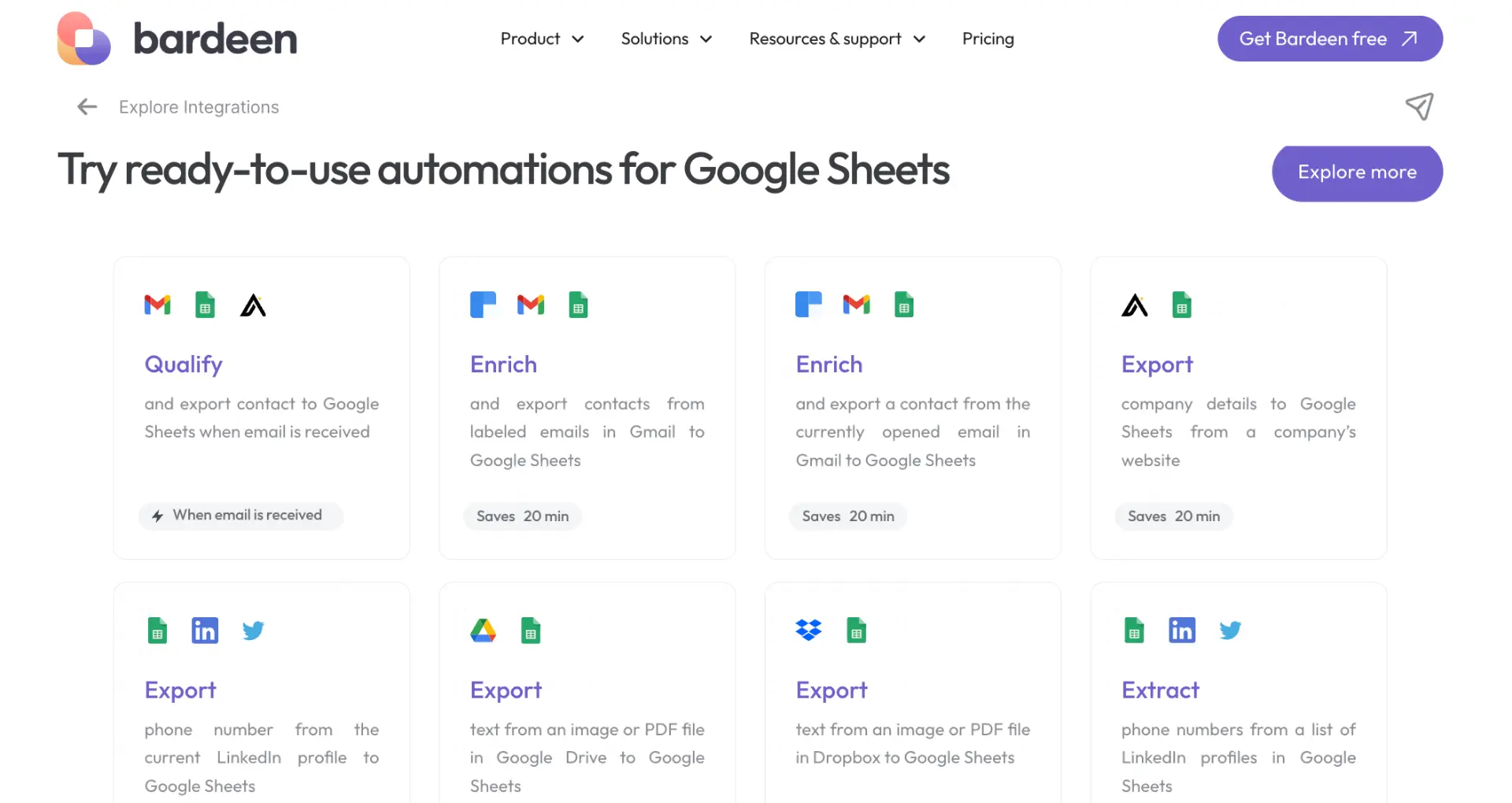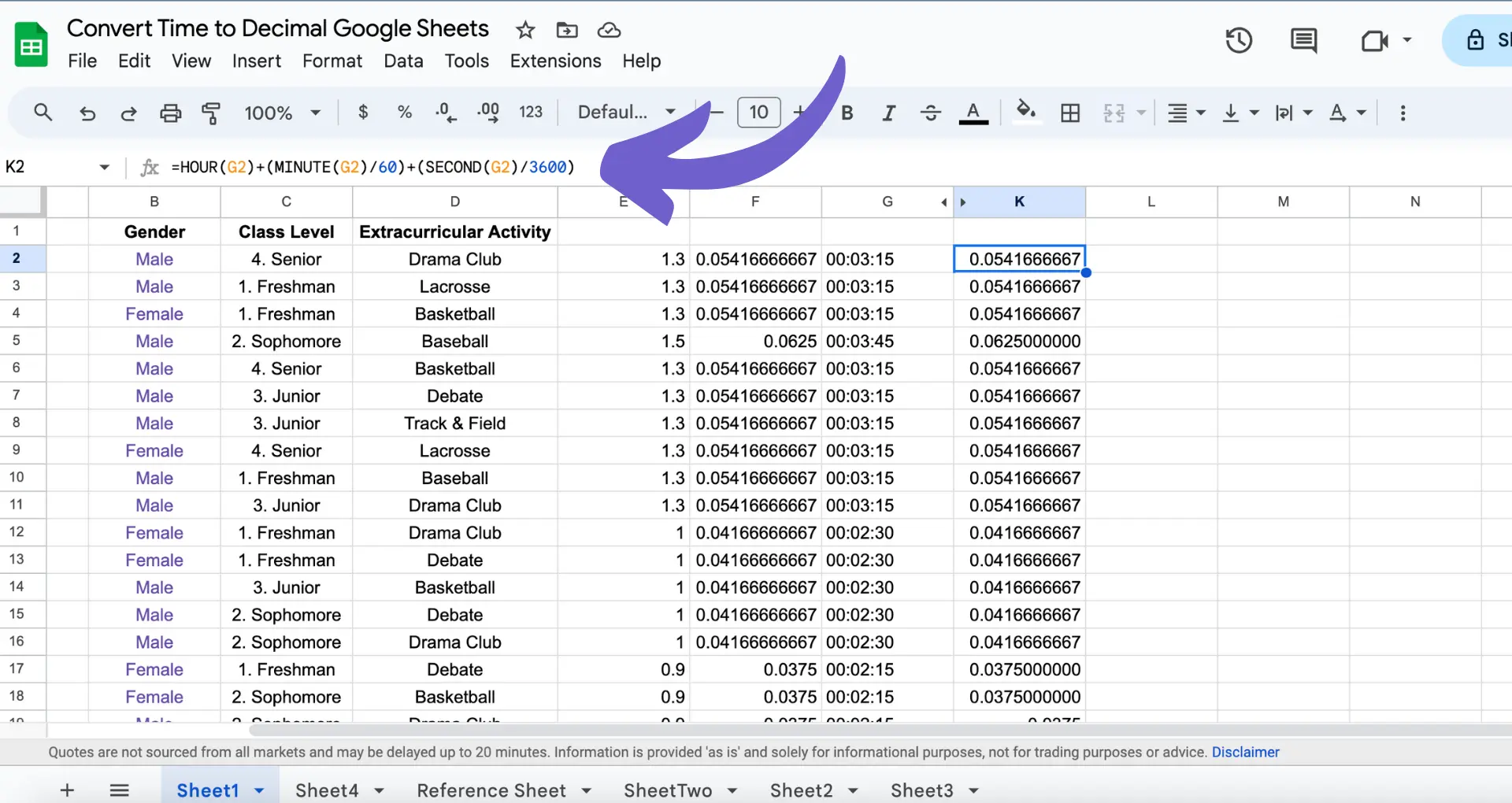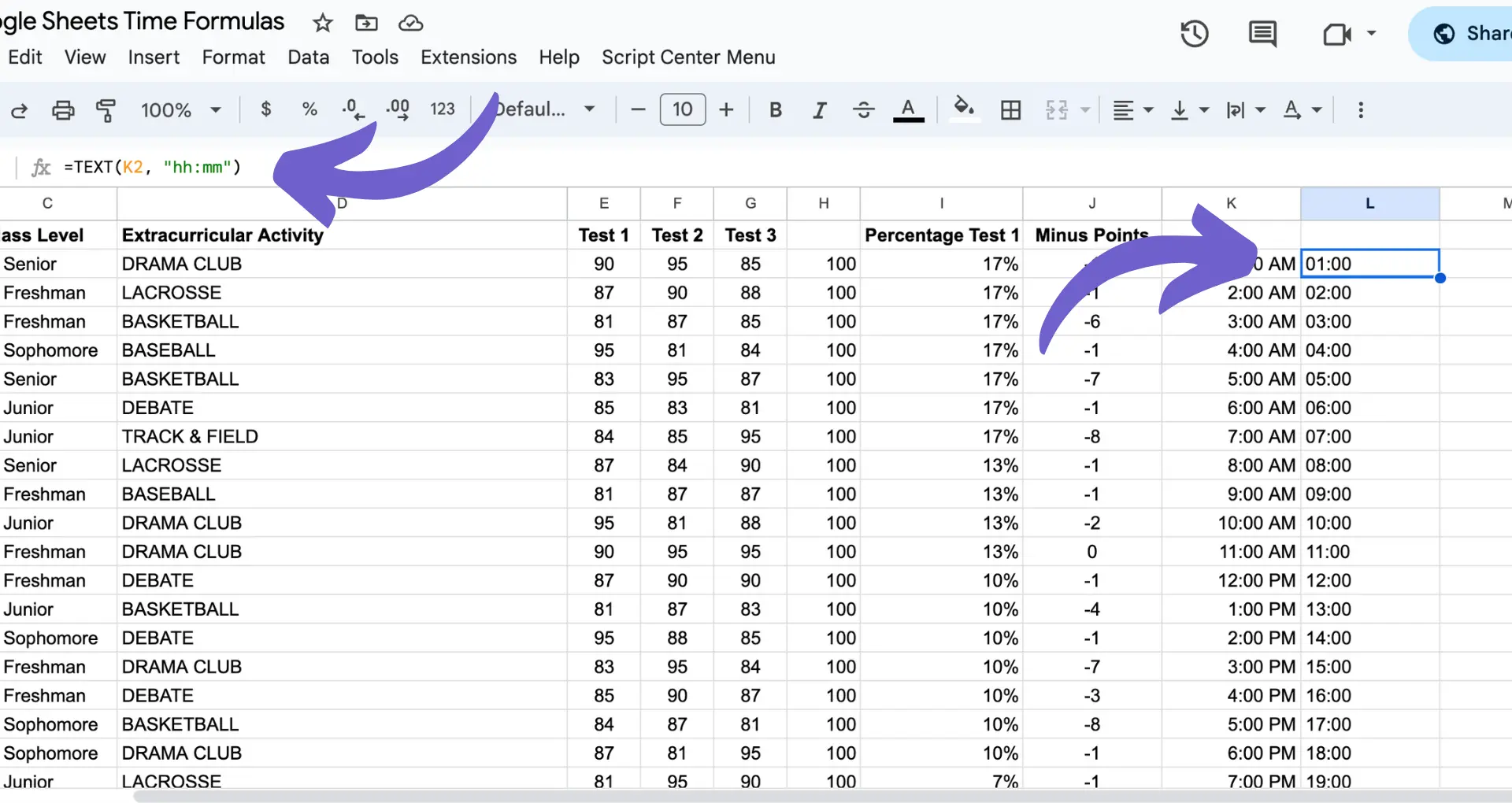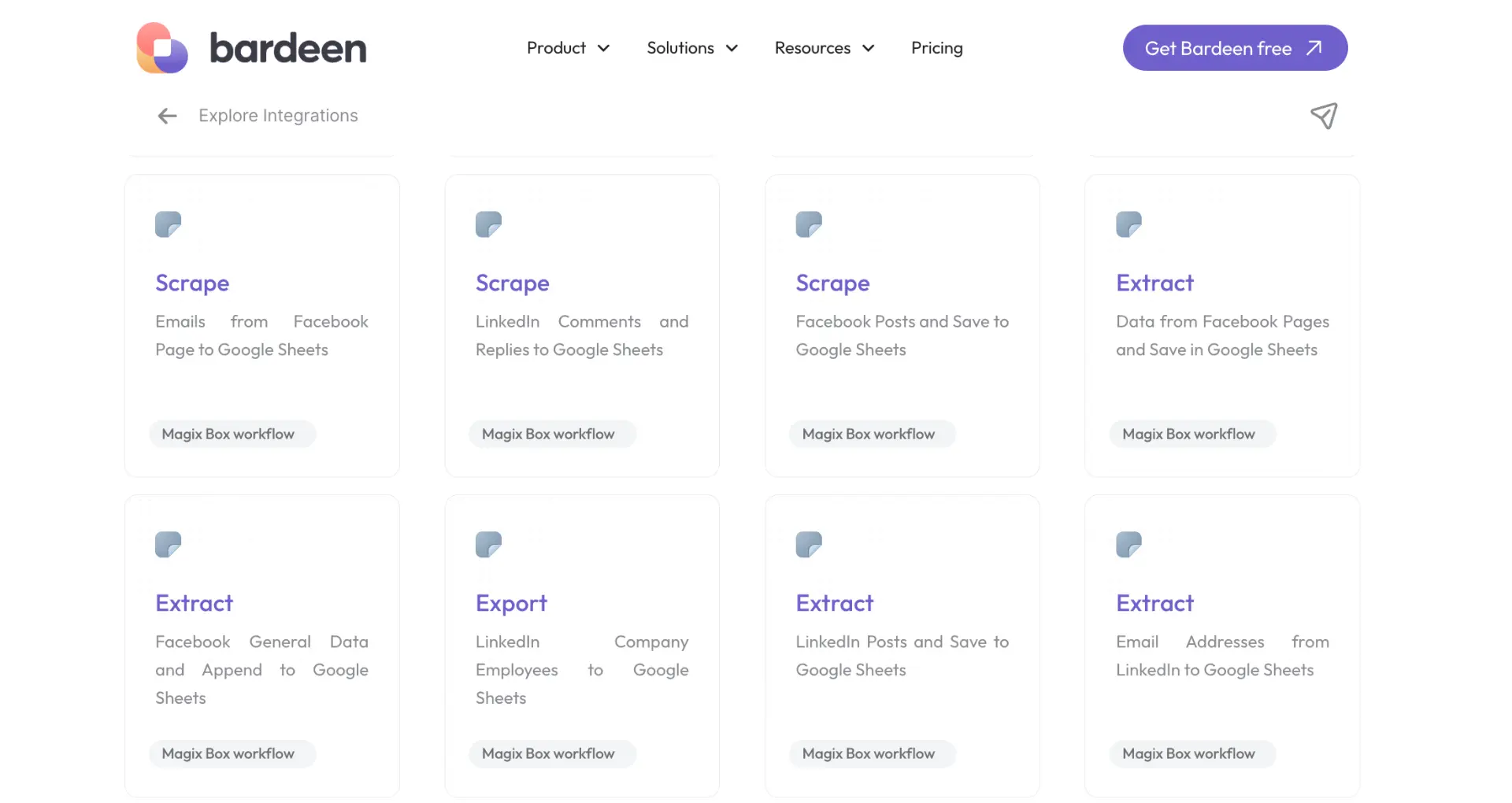Use =HOUR(A1)+MINUTE(A1)/60 to convert hours to decimals in Google Sheets.
By the way, we're Bardeen, we build a free AI Agent for doing repetitive tasks.
If you're dealing with time data, Bardeen's GPT in Spreadsheets can automate and simplify your work. Save time and reduce errors with AI-powered conversions.
Converting hours to decimals in Google Sheets is a crucial skill for tasks like payroll calculations and project management. In this step-by-step guide, we'll walk you through the process of converting time data into decimal format, from understanding how Google Sheets interprets time to utilizing advanced formulas and automation techniques. By the end of this guide, you'll be able to efficiently and accurately convert hours to decimals in your Google Sheets projects.
Understanding Time Formats in Google Sheets
Before diving into converting hours to decimals, it's essential to understand how Google Sheets interprets and displays time data. Google Sheets recognizes various time formats, including standard formats like "HH:MM:SS" and "HH:MM AM/PM," as well as decimal time formats.
Standard time formats are useful for displaying time in a human-readable format, such as "9:30 AM" or "14:45:00." However, when it comes to calculations and data analysis, decimal time formats are often more convenient. Decimal time represents hours and minutes as a decimal number, with hours being the whole number and minutes expressed as a fraction of an hour.
For example, 1.5 in decimal time represents 1 hour and 30 minutes (1 + 0.5), while 0.75 represents 45 minutes (0 + 0.75). Understanding the difference between these formats is crucial for effectively converting and working with time data in Google Sheets.
Preparing Your Data for Conversion
Before converting hours to decimals in Google Sheets, it's crucial to ensure your data is correctly formatted. This preparation step will make the conversion process smoother and more accurate. Here are some key steps to follow:
- Ensure your time data is in a consistent format across your dataset. For example, if some cells use "HH:MM" and others use "HH:MM:SS," standardize the format to ensure the conversion formula works correctly.
- If your data includes AM/PM indicators, consider using a 24-hour format instead. This will simplify the conversion process and reduce the risk of errors.
- Check for any invalid or missing time entries in your dataset. These can cause issues during the conversion process and should be addressed before proceeding.
Another important step is to create a backup of your data before making any bulk changes. This will allow you to revert to the original data if needed, providing a safety net in case anything goes wrong during the conversion process.
By taking the time to properly prepare your data, you'll set yourself up for a successful and efficient conversion of hours to decimals in Google Sheets. For more advanced features, you can connect Google Sheets with other tools to enhance your workflow.

Save time on repetitive tasks by integrating Google Sheets with Bardeen. Automate actions and keep your data in sync effortlessly.
Basic Conversion Formula Explained
To convert time in the "HH:MM" format to decimal hours in Google Sheets, use this basic formula:
=HOUR(A1)+MINUTE(A1)/60

Here's how each part of the formula works:
- HOUR(A1) extracts the hour component from the time in cell A1. For example, if A1 contains "12:30", HOUR(A1) will return 12.
- MINUTE(A1) extracts the minute component from the time in cell A1. In the same example, MINUTE(A1) will return 30.
- MINUTE(A1)/60 divides the extracted minutes by 60 to convert them to a decimal fraction of an hour. In this case, 30/60 equals 0.5.
- Finally, the formula adds the extracted hour and the decimal fraction of an hour to get the result in decimal format. In our example, 12 + 0.5 equals 12.5, representing 12 hours and 30 minutes.
This basic formula can handle most standard time entries. However, for more complex scenarios, such as accounting for seconds or converting time beyond the 24-hour format, you may need to use more advanced techniques. Also, consider using GPT in Spreadsheets for more automated solutions.
Advanced Techniques for Time Conversion
For more complex time conversion scenarios, you can use custom formulas in Google Sheets to handle specific cases, such as accounting for seconds or converting time beyond the 24-hour format. Connect Microsoft Excel for more advanced options.
Here are a few examples of advanced formulas:
- To convert time in the "HH:MM:SS" format to decimal hours, use: =HOUR(A1)+MINUTE(A1)/60+SECOND(A1)/3600
- To convert time greater than 24 hours to decimal hours, use: =MOD(HOUR(A1),24)+MINUTE(A1)/60+SECOND(A1)/3600
- To convert decimal hours to the "HH:MM:SS" format, use: =TEXT(A1,"[hh]:mm:ss")
These formulas can be customized further to handle specific edge cases in your time data. For example, you can use conditional formatting to highlight cells with invalid time formats or create a script to automate the conversion process for large datasets.
Streamline your workflows by using Bardeen's automation app to convert complex time data effortlessly, saving you precious time.
By mastering these advanced techniques, you can ensure accurate time conversions in Google Sheets, even for complex scenarios.
Advanced Techniques for Time Conversion
For more complex time conversion scenarios in Google Sheets, you can use custom formulas to handle specific cases like accounting for seconds or converting time beyond the 24-hour format. Here are some examples:
- To convert time in the "HH:MM:SS" format to decimal hours, use: =HOUR(A1)+MINUTE(A1)/60+SECOND(A1)/3600
- To convert time greater than 24 hours to decimal hours, use: =MOD(HOUR(A1),24)+MINUTE(A1)/60+SECOND(A1)/3600
- To convert decimal hours to the "HH:MM:SS" format, use: =TEXT(A1,"[hh]:mm:ss")

These formulas can be customized further to handle edge cases in your time data. For instance, you can use conditional formatting and web scrapers to highlight cells with invalid time formats or create a script to automate the conversion process for large datasets.
By mastering these advanced techniques, you can ensure accurate time conversions in Google Sheets, even for complex scenarios. This will help automate tasks like payroll calculations and project management, saving you time and reducing errors.
Utilizing Time Conversion in Payroll Calculations
Decimal time is commonly used in payroll systems to accurately calculate employee wages. By converting hours worked into decimal format, it becomes easier to multiply the total hours by the hourly rate to determine the correct pay.
Here's a step-by-step guide on using converted decimal times for payroll calculations:
- Convert the start and end times for each employee into decimal hours using the formulas discussed earlier.
- Subtract the start time from the end time to calculate the total decimal hours worked.
- Multiply the total decimal hours by the employee's hourly rate to determine their gross pay.
- Apply any necessary deductions or taxes to the gross pay to calculate the net pay.
For example, if an employee worked from 9:00 AM to 5:30 PM (8.5 hours) at a rate of $20 per hour, you would first convert the time to decimal hours (8.5), then multiply it by their hourly rate (8.5 * $20 = $170) to determine their gross pay for that day.
By mastering time conversion and utilizing decimal hours in your payroll calculations, you can ensure accurate payments and maintain precise records for your business. Learn more about efficient lead management to enhance your business operations.
Utilize Bardeen to scrape data directly into your payroll system to automate parts of your data collection process, saving you valuable time.

Automating and Troubleshooting Conversions
To streamline the time conversion process in Google Sheets, you can leverage built-in features like scripts and conditional formatting. Here are some methods to automate your conversions:
- Use Google Apps Script to create custom functions that handle complex time conversions, such as accounting for daylight saving time or converting across multiple time zones.
- Implement conditional formatting rules that automatically apply specific formatting to cells containing time data in a particular format or range.
- Create scripts that automatically convert time data in a sheet when triggered by events like opening the sheet or editing a cell.
When troubleshooting issues with time conversions, keep an eye out for these common problems:
- Incorrect time formats in your source data can lead to errors like #VALUE!. Ensure your time data is consistently formatted before attempting conversions.
- Formulas that don't account for daylight saving time changes may produce incorrect results during certain times of the year. Double-check your formulas and consider using scripts or custom functions in Google Docs to handle these edge cases.
- Mixing 12-hour and 24-hour time formats within the same dataset can cause inconsistencies in your conversions. Standardize your time format before proceeding with conversions.
By automating your time conversions and being aware of potential pitfalls, you can ensure accurate and efficient data management across multiple time zones in Google Sheets. For more advanced automation tips, check out how to build a prospect list in Google Sheets.
Automate Google Sheets for Efficiency with Bardeen
Converting hours into decimals in Google Sheets is a task that can significantly benefit from automation, especially when dealing with large datasets or frequent updates. While the manual method described helps with individual conversions, automating this process can save a considerable amount of time and reduce the possibility of errors. With Bardeen, you can set up automations that handle data processing in Google Sheets seamlessly.
- Get a daily summary of your emails and save to Google Sheets: This playbook automates the process of summarizing your emails and saving them into a Google Sheets document daily, perfect for tracking time spent on email communication.
- Copy all Github issues to Google Sheets: For teams using GitHub, this automation streamlines the management of issues by copying them directly into a Google Sheet for tracking and analysis.
- Copy a newly created Asana task to Google Sheets: This playbook ensures that every new task created in Asana is automatically added to a Google Sheets spreadsheet, aiding in project management and time allocation tracking.
Implementing these automations can significantly enhance productivity and ensure that your data is always up-to-date. Start exploring these possibilities by downloading the Bardeen app at Bardeen.ai/download.





.svg)
.svg)
.svg)
